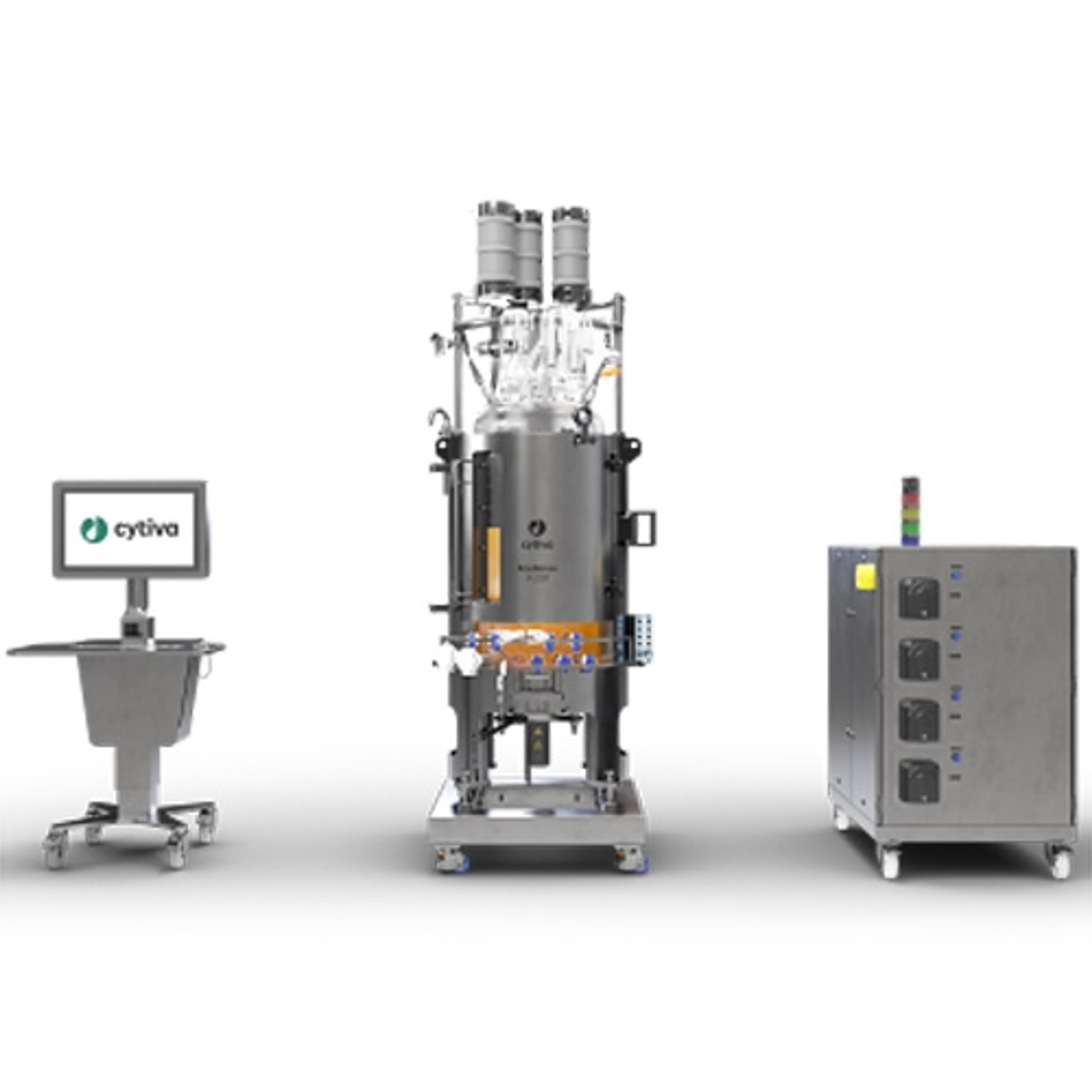Insights into the world of single-use technology
A panel of experienced specialists explore the significance of single-use technology (SUT) in biopharmaceutical manufacturing and biotechnology
18 Dec 2023

Single-use technology, often referred to as SUT, represents a significant change in biopharmaceutical manufacturing. Unlike traditional stainless-steel equipment that needs thorough cleaning and sterilization, single-use technology employs disposable components like bioreactors, filters, and tubing. This approach not only simplifies the manufacturing process, but also reduces the need for large investments in equipment and can have a positive environmental impact.
We spoke with a panel from Cytiva including Fredrik Lundström, Senior Product Manager, Jerry Branscomb, Senior Strategic Project Manager, and Joe Makowiecki, Director of Product Management and Support for Enterprise Solutions about single-use technology, its evolution, the impact on upstream and downstream processes, and its sustainability benefits.
Single-use technology innovations
Single-use technology (SUT) has become increasingly important within various industries, particularly in biopharmaceutical manufacturing and biotechnology. One of its key advantages is its flexibility. Disposable components eliminate the need for expensive, time-consuming, and resource-intensive cleaning procedures, making it easier to adapt to changing production requirements.
Fredrik Lundström, Senior Product Manager at Cytiva, has over a decade of experience in SUT product management, including the development of several chromatography and filtration systems. Lundström shares, “It is costly to set up a production line for biopharmaceuticals, so high utilization in the facility is often the most important factor in lowering the production cost per dose or gram. SUT removes the need for cleaning and verification of cleaning between batches, which increases productivity in the facility.” SUT is also beneficial for those who require rapid facility setup. “Single-use technology reduces the complexity of the installation and the time it takes to commission and qualify,” Lundström says. “Once the installation is completed, the validation work starts where the cleaning validation can demand a good portion of resources. Here, the effort needed is reduced significantly, which means less time and resources to get through the validation phase.”

To provide further insight into SUT, we spoke with Joe Makowiecki, Director of Product Management and Support for Enterprise Solutions at Cytiva. He manages the company’s FlexFactory™ biomanufacturing process train as well as its KUBio™ modular facility solutions.
With a wealth of experience in this field, Makowiecki has observed firsthand how SUT has developed over the years. “If you look at the preclinical and early phase clinical work, around 85% of the developers utilize single-use technologies, so it’s commonplace right now,” he explains. When it comes to maximizing capacity utilization and accelerating the setup of new facilities, Makowiecki says, “SUT does help to advance technology. Whether it’s a more traditional recombinant protein or monoclonal antibody, or the full spectrum of new product modalities such as viral vectors, pDNA, or mRNA, SUT provides manufacturing platform flexibility and adaptability that you don’t necessarily achieve with a fixed asset, like a stainless steel manufacturing platform.”
Jerry Branscomb, Senior Strategic Project Manager for Cytiva, further explains the benefits of the technology by drawing from over 30 years of SUT experience in biopharmaceutical and medical device applications. “The best way to add value to new SUT products is to first understand the challenges with existing applications. As new molecules, therapies, and workflows are developed, there are often new requirements or areas of focus around the changing processes.” In addition, SUT facilitates the expansion of biomanufacturing capacity, Branscomb says. “Typically, the use of SUT versus clean-in-place [CIP] required extensive facility validations to ensure that new piping, boilers, clean steam generation, and CIP processes were working as intended. This requires large amounts of time prior to production being able to commence. These processes also involve much longer lead times than SUT. In most cases, SUT is also found to be more sustainable.”

There is no denying that SUT brings numerous benefits, such as flexibility, cost savings, and the capacity to speed up facility setup, establishing itself as a crucial asset in the biopharmaceutical and biotechnology sectors.
Upstream and downstream process integration
SUT has revolutionized upstream and downstream processes in biopharmaceutical manufacturing, improving efficiency and flexibility throughout the production cycle. When using SUT, the transition or changeover between different production campaigns can be more efficient and streamlined compared to traditional methods. SUT reduces the need for extensive cleaning and validation processes, making it easier and quicker to switch from one production campaign to another.
Lundström specifically discusses the advantages linked to downstream processes. “The general benefit is the changeover between campaigns,” he says. “The cleaning and potentially changing elastomers take time. How this affects the overall operation efficiency depends on the scheduling of the facility.” He continues, “For single-use systems, there are aspects like a wide operating range which reduce the need to have several systems with different sizes.”
To delve deeper into this topic and explore the methods for enhancing efficiency in both upstream and downstream processes, Makowiecki concurs that the manufacturing start-up time is much faster from a single-use standpoint. “The time to go from one unit operation to the next or from one product to another is significantly shorter due to the reduction or elimination of time-consuming cleaning and cleaning verification testing. The use of SUT saves time, simplifies changeover procedures, and lowers the risk of crossover contamination,” he states.
With a specific focus on liquids and buffers, Branscomb explains, “Depending upon how it is used, SUT allows formulations and aliquots to be prepared, filled, and dispensed with no risk of residual or cross-contamination. When SUT is used downstream of the actual media and/or buffer prep, the fluid paths and sterilization filters can also be single-use. This requires less time for setup and decreases risk.”
Single-use vs reusable technology
Manufacturers typically decide whether to use single-use technology or reusable options (like glass or stainless steel) based on the stage of development, the specific process, and economic considerations.
“In very early process development at lab-scale, it is common to use conventional technology in downstream operations,” Lundström explains. “Single-use equipment is quite common at the preclinical stage, as sometimes the production line is combined with production of phase I material. Phases I and II are really the sweet spots for single-use equipment.” To discuss this further, Makowiecki says, “As you move from process development to process scale-up, that’s where you see most developers transitioning from a hybrid approach, with a mixture of clean and re-use technologies and SUT, to an all single-use approach. Nevertheless, it depends upon your process needs and the scale that you’re targeting. Are there some capabilities from a process standpoint—whether it’s temperature compatibility or chemical compatibility where you may have to go hybrid?” Branscomb adds, “It’s always preferable to use the same materials and processes in development that you would plan to use in larger scale manufacturing. The primary reason that may drive the use of reusable technology is in early phases where the cost of the SUT systems at smaller scale is more than the cost of the labor and cleaning of legacy technology. If the larger scale requirements of the workflow are limited to traditional systems, then SUT may not be preferred in the development scale.”
Tips and strategies for single-use technology
To unlock the full potential of SUT, it is essential to harness expert insights and strategies to push the benefits even further.
Sharing his knowledge, Lundström states, “An important aspect when using single-use technology is that it becomes an integral partner of your supply chain. Therefore, it is of vital importance to select suppliers with good continuity plans to avoid disruptions in production. You can also check if your suppliers are ISO 22301 certified for business continuity management.” He continues, “Another aspect is to select technology that is scalable and easy to transfer. The scale increases as you progress through the clinical trials, and you are often under time pressure to move quickly through the stages.” To provide additional assistance, the experienced team at Cytiva offers training. “We offer various levels of training, from a brief introduction and overview of systems to a couple days of more detailed training. We also started offering virtual reality training of some systems too.” He continues, “there are a lot more manual interactions with single-use systems compared with conventional systems, so the need for training is higher.”
Makowiecki also offers advice to new users. “It all goes back to understanding your process and your product quantity requirements, which in turn will dictate your manufacturing scale - then looking at the capabilities, compatibility, and the availability of single-use technologies that will meet your manufacturing needs.” He also recommends reaching out to vendors to better understand your single-use options, as “many vendors have a tremendous amount of experience and expertise. At Cytiva, we provide end-to-end, single-use products and solutions to the biopharmaceutical industry and all these products and solutions are backed and supported by Cytiva’s extensive knowledge and experience with the development, scale-up and manufacture of vaccines and therapeutics. In our industry, credibility is one of the keys to success.”
Branscomb similarly shares his insights. “Seek the advice and participation of subject matter experts within either of the technologies before deciding which you want to use. It’s also valuable to understand the limitations or safety concerns of certain processes that would favor one technology over another and ensure that the proper designs and materials are used.”
The path to greener operations
In today’s rapidly changing world, taking care of the environment has become more and more important. This is particularly true when using SUT, which has sometimes been viewed as less environmentally friendly.
Lundström explains, “Single-use can be perceived as a poor sustainable solution, since you see plastic items being disposed of and you don’t easily see all the energy and water consumed in a stainless steel facility. Single-use technology reduces the facility and clean room footprint, which reduces energy use.”
To expand on this further, Makowiecki states, “When you actually look at the use of plastics in the biopharmaceutical industry, it’s only a small percentage compared to the use of plastics globally. In addition, several lifecycle assessments have been performed and published to investigate the impact of single-use versus stainless steel manufacturing. The evidence shows that the life cycle environmental impacts of single-use are lower than those for stainless steel across a range of impact categories such as carbon, energy, and water footprint.”
Despite the small percentage of plastics used by the biopharmaceutical industry compared to the total of plastics used globally, and the favorable results of single-use versus stainless steel life cycle assessments, every single-use vendor must do their part to reduce environmental impact and drive sustainability.
Future outlook
Lundström offers his perspective on the future, pointing out that SUT aligns well with emerging therapies such as viral vectors and nucleic acids. “There are still important improvements being made in the technology applicable to downstream, and the conversion to single-use will continue to increase in the future. Having said this, single-use is not a universal solution that will fit in every instance. Stainless steel is more suitable for the production of large-volume biopharmaceuticals.”
When asked about the future, Makowiecki shares his insights. “We know that single-use technologies have advanced and evolved to the point where we now have complete end-to-end solutions to accommodate increased manufacturing scales. Going smaller is yet another evolution of single-use technologies. The growth of newer product modalities and personalized medicines are driving down the scales needed for manufacturing, so vendors need to ensure that single-use technologies can also accommodate smaller scale manufacturing.” He continues, “In addition to accommodating smaller scale manufacturing, you’ll also see a significant increase in SUT sustainability efforts focusing on recycling, re-using, and re-purposing plastics, including replacing traditional plastics with ones that are more environmentally friendly and sustainable.”
Branscomb concludes by sharing, “Large-volume batches will be used for several more years in new and developed processes, but SUT will continue to have a larger footprint in those manufacturing schemes as materials and design features continue to be developed. The increasing presence of gene therapies and especially cell therapy and personalized medicines will create an increasing demand for SUT.”






